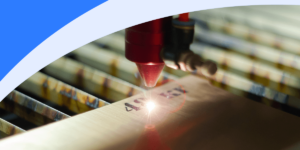
Laser marking is an efficient, practical and cost-effective process for permanently marking a material. Doing so is valuable in adding your company’s branding or identifiers that promote product traceability. Various methods exist for creating ideal results, and choosing the best one for your application starts with understanding your options.
The following six laser-marking techniques are the most common in modern manufacturing.
Laser ablation is the precision removal of material using a beam without damaging the product. The laser “strips” the surface coatings or layers and leaves a high-contrast marking perfect for applying bar codes or serial numbers. This technique is ideal for painted goods, anodized aluminum, black oxides and other materials.
Laser annealing works with materials that contain carbon, such as steel alloys and iron. The method relies on heat to spur oxidation, creating smooth, high-detail markings. Typically, the results are black, but colors can differ based on the exact temperature applied. Annealing is ideal for marking medical devices, where industry regulations prevent etching or engraving that could weaken an instrument.
Carbon migration also involves applying heat to a metal or metal alloy material but at a faster rate. The high temperature breaks the chemical bonds between the metal and carbon, causing the latter to rise to the surface. This method produces very dark markings and is common in aerospace and automotive manufacturing.
Laser coloration uses carefully controlled oxidation processes to create a specific hue — you adjust variables like beam width, pulse length and material to produce the desired color. This method’s typical use cases include decorative applications and jewelry-making because it’s compatible with plastics and metals.
Deep engraving involves using lasers to remove many thin layers of stock on to-spec products that often have abrasive operating environments or extra coatings applied. The relief this technique leaves behind is both visible and tactile, and it’s most common in military applications.
Foaming is for plastic materials, with darker ones preferred since the markings are generally light colors like cream, tan or white. The laser system melts the material, causing foam and gas bubbles to form. These bubbles alter the material’s light refraction characteristics to create a visible contrast. Common applications for foaming include keyboard manufacturing and cosmetic packaging fabrication.
Laser frosting is compatible with metal and glass materials. It’s also compatible with other marking techniques, like annealing, to produce unique light-and-dark results. This method relies on high laser scan speeds that only slightly penetrate the surface and make bright white markings. Standard uses for laser frosting include minting stamps, surface texturing and privacy glass.
Laser Marking Technologies, LLC is a market-leading provider of high-quality lasers for marking, etching and engraving. We have over two decades of experience and a team with more than a century of collective industry expertise. Our solutions feature advanced technology, competitive pricing, industry-leading warranties and 100%-made-in-the-USA quality.
Browse our entire lineup of laser systems and request a quote, or contact an expert for personalized advice.